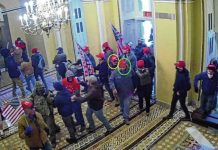Columbus will install “traffic calming” measures on 17th Street between Washington and Lafayette, but with a catch — these new features will only be up for a month.
The Columbus Board of Public Works approved this temporary installation at a meeting Tuesday morning. According to a release from the City of Columbus — Bartholomew County Planning Department, the traffic calming project will be installed Aug. 30 through Oct. 1 and is a partnership between the city and Columbus Regional Health Healthy Communities.
Staff from the city’s engineering and planning departments will host a walk-through of this upcoming project at 6 p.m. Wednesday. Those wishing to participate should meet at the northeast corner of 17th Street and Lafayette Avenue in Donner Park where the project will be discussed in greater detail and initial feedback will be requested.
The project provides a chance for the city to “test the impact of the traffic calming design elements and collect further public feedback before making final design decisions for the street,” planning officials said.
Traffic data and public input will be collected during the temporary installation, and the materials will be removed after it ends. Future, permanent traffic calming elements will be decided based on this trial run, said Senior Planner Emilie Pinkston.
The project will consist of the following elements:
A traffic diverter at the 17th and Washington intersection to prevent vehicles traveling on Washington Street from making eastbound turns on to 17th Street and prevent those traveling eastbound west of Washington Street from continuing east. The diverter is meant to limit motor vehicle volumes while still allowing bicycle passage.
A traffic circle and four-way stop at the 17th and Franklin intersection, intended to slow vehicles’ speeds.
A four-way stop at the 17th and Lafayette intersection, to be paired with painted crosswalks at the entrance of Donner Park.
Materials used will include traffic paint, vertical delineators, planters and signage describing the project’s intent and offering opportunities for feedback.
“The hope is that these traffic calming elements slow vehicular traffic, improve safety and comfort for bicyclists and pedestrians, and enhance the neighborhood for residents,” planning officials said.
The city’s Department of Public Works will handle the installation, and Cheryl Wright with CRH Healthy Communities will help coordinate so that there will be planters with mums and other flowers as part of the installation.
The project is inspired by public input. In October of 2020, the city collected feedback on potential bicycle and pedestrian improvements along 17th and 19th Streets between Noblitt, Donner and Lincoln Parks.
During this outreach effort, the city asked for input on two types of bicycle facilities — a shared use path and a bicycle boulevard. The former is a shared pathway next to the street for both cyclists and walkers. The latter is a street with “low motorized traffic volumes and speeds designed to give bicycle travel the priority.”
The project at 17th Street is a way for the city to explore the traffic calming elements seen in a bicycle boulevard and respond to feedback about the option.
During the feedback campaign, members of the public indicated that traffic speeds on 17th Street between Washington and Lafayette are too high, especially when it comes to cars going north on Franklin or south on Lafayette, Pinkston said. Public input also indicated that on-street parking is “desperately needed” on 17th Street, and any changes made should accommodate this need.
“We also heard that, just in general, bicyclists are not comfortable sharing the roadway with motor vehicle traffic in its current condition,” she added.
Both the input and “site constraints” of the area led planning staff to pursue the idea that bicycle boulevard elements might better fit this section.
Executive Director of Public Works/City Engineer Dave Hayward, who lives in a neighborhood near the project area, said that data collection before and during the project should also provide helpful information about traffic speeds in the area, as well as the impact of stop signs.
“Obviously, at the stop sign itself, traffic is slowed down,” he said. “But you get a block or two up the road, are you trying to make up for that lost time? Or I’ve actually seen cases where a block or two away, traffic speeds increase. So we want to try to measure that effective zone to see how far that stop sign affects speed limits.”
The project is supported by a $6,000 Tactical Urbanism grant from the Indiana State Department of Health, which Pinkston said will cover all of the materials.




